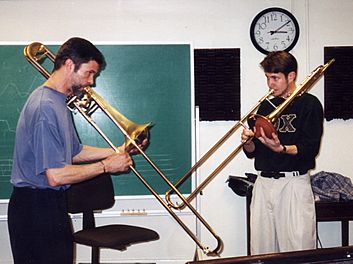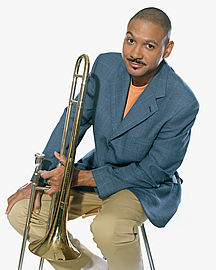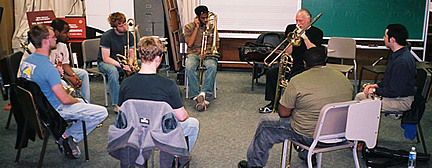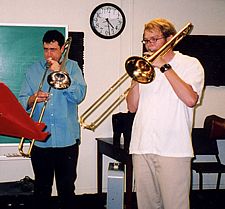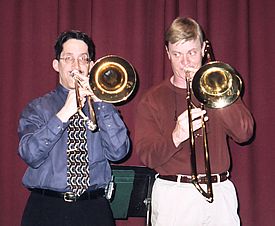by Antonio J. García
Associate Jazz Editor, ITA Journal
Perhaps no single musical element identifies jazz musicians more than their personal sound. Given the liberties jazz players may constantly choose that the classical genre does not so frequently allow, the section leaders of jazz bands—much less their soloists—can be readily identifiable in as soon as a single note.
Technology has evolved along with jazz, particularly the amplification of live and recorded sound. The electronics have influenced the players and vice-versa. And after some 90 years of jazz history, we are at a point where differences of opinion often divide trombonists and their listeners as to what that sound should be.
Does playing trombone solos close-mic in some way “cheat” or disrespect the sound of what I might call, for lack of a better brief term, the “full-on,” more mic-distant and open trombone-soloing tradition? Are there advantages, disadvantages, differences, and/or prejudices? I have personally witnessed—as with such heady subjects as politics and religion—heated debates that can occur between respected individuals on and after the gig about the topic of the microphone and its relationship to the sound of the jazz trombone.
So I figured it was high time we look at the topic in our ITA Journal. In a highly unscientific manner, I contacted some 30 respected players and inquired about their views. I reached out across continents, genders, and age groups. More than half of them replied, and not all “for the record.” One trombonist who described it as “a beautifully volatile topic” captured the thoughts of some participants. And two well-known performers did expressly decline to share any thoughts for publication, one stating “I wouldn’t get in the middle of that,” another not wanting to “jump in this quagmire of dissension.”
I doubt that any discussion regarding “the ideal jazz trombone sound” would last long: jazz, by its definition, calls for individuality of expression. What I hope to do is illuminate the understandings that provide the foundation for various schools of thought on the issue so that hopefully everyone can come away from this with not only a more thorough understanding of the position they themselves hold but also a more healthy respect for the logic of any opposing view(s). That, to me, is good education.
None of the trombonists quoted within this article had access to the others’ replies; so I am grateful to each for their willingness to contribute their thoughts independently. Some of their answers are presented anonymously.
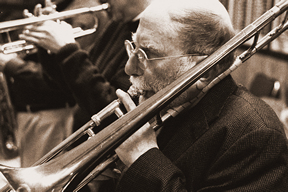 |
Allen courtesy |
Influences
Antonio García: When you were developing your sound early on, which trombonists particularly inspired you with their close-mic sound?
Various: Albert Mangelsdorff, Bill Reichenbach, Bill Watrous, Bob McChesney, Carl Fontana, Curtis Fuller, Dante Luciani, David Gibson, Frank Rosolino, Hal Crook, Harry Waters, Jiggs Whigham, Jim Pugh, Joe Prejean, John Fedchock, Lawrence Brown, Paul McKee, Quentin Jackson, Slide Hampton, Urbie Green.
Steve Wiest: Carl Fontana and Bill Watrous. It seemed to me that in those days Jim Pugh was doing some live Woody Herman recordings with the close-mic sound as well. I really enjoyed the efficient-sounding nature of this lighter sound—and the “beyond-trombone” quality it produced.
Deborah Weisz: I really loved Carl Fontana’s sound, on mic or off. I didn't really think of Carl's sound as a “close-mic” sound, just as a wonderful, warm sound on the trombone.
Ray Anderson: I had no concept about mics. I’m old enough to have grown up in the pre-PA period. A big sound was a goal and a necessity. I played rhythm-and-blues; and PA’s were rudimentary, to say the least. Usually only vocalists had mics.
García: And which trombonists inspired you with their open-horn sound?
Various: Al Grey, Andy Martin, Carl Fontana, Conrad Herwig, Curtis Fuller, Dave Bargeron, Frank Rosolino, Fred Wesley, Freddie Assunto, J.J. Johnson, Jack Teagarden, James Pankow, John Allred, Lawrence Brown, Phil Wilson, Quentin Jackson, Slide Hampton, Tom “Bones” Malone, Tommy Dorsey, Tricky Sam Nanton, Trummy Young, Tyree Glenn, Urbie Green, Vic Dickenson, Wayne Henderson.
Allen Hermann: There are wonderful players such as Wycliffe Gordon who defy classification!
Doug Sertl: The trombonists that inspired me as a young player and even today have nothing to do with how they use a mic. It’s all based on how they play: their musical ideas, mastery of the instrument, soul.
Anderson: I’ve always been inspired by people with big sounds: Vic Dickenson, Trummy Young, J.C. Higginbotham, Dickie Wells, Bennie Morton, and the like.
Jiggs Whigham: Most all classical trombonists have a great open-horn sound, as well as so many jazz players.
Wiest: One of the greatest exponents of using both sounds is my absolute hero on the instrument: Slide Hampton. Whichever direction or sound Slide chooses always seems to be natural and musically appropriate.
John Fedchock: My first inspirations to become a jazz trombonist all came through listening to studio recordings; so, in essence, every trombonist was close-miked. Check out YouTube, and look at the distance the microphone is from a variety of players. The proximity of the microphone is similar in most instances. The sound engineer has the power to turn the level up or down. Close-miking is not really the issue here: this is really more of a playing-volume issue.
Some may say that this is a trombone-sound issue. But I have worked alongside some of the giants of the jazz trombone, and I personally find no distinction between players’ personalized “open-horn” sound and the volume they are playing. Slide Hampton’s sound at a soft volume has the same dark richness as it does at louder volumes. Urbie Green’s sound, belting it out at his loudest, still has all the beauty of his soft ballad playing. I’ve stood next to Al Grey playing coolly into a microphone and heard the same brilliant sound he displayed when crackling through a plunger. I’ve also sat six feet in front of Carl Fontana while he tried horns for an hour, putting them through their paces at all volumes. His inherent sound remained the same.
|
Ray Anderson and Mark Blankenship at Virginia Commonwealth University. photo credit: |
|
Bluffing?
García: Some trombonists find close-mic soloing a cop-out, saying that it masks the true “open-horn” sound of the instrument. Your thoughts?
Michael Davis: I couldn’t disagree more. Seems to me, Carl and Frank both had great sounds whether they were playing into a mic or not. The players I like today are the same way.
Wiest: I agree and yet disagree here. It does indeed mask the true open-horn quality of the trombone, but I find that sound to be very attractive and desirable. It adds one more color to the compositional palette of improvisation. I think of the close-mic sound in the same manner as I consider a mute.
Anderson: I think it’s very important to develop a sound that represents you. I don’t believe one should rely on a microphone for that. But perhaps you play quietly.....
I just heard Slide Hampton with two young trombonists and marveled at the way they could all stand perfectly still and play with the mics right on their bell. I could never do that. Different strokes for different folks.
I’ve been using a clip-on mic and a wireless transmitter/receiver for some years. The clip-on might seem like the ultimate in close-miking, but actually it functions like no-miking in that the dynamics have to produced by the musician. You can’t swallow it and make your soft stuff loud, and you can’t get away from it to make your loud stuff softer. I love it because I can wander around the stage and bend over or whatever I need to do without my sound going out of the PA.
Hermann: Let me hear their sounds and articulations open-horn before I pass judgment.
Rick Simerly: I don’t feel that close-mic is a “cop-out.” Obviously if you get too close to the mic, the natural sound of the ’bone is affected; but most players who use the mic know how to do it. They usually know the correct distance from the mic, exactly what they want in the sound and for the EQ [equalization] of the instrument.
It could also be argued that the true sound of the instrument is the controlled sound that a close-mic player gets. It isn’t forced or out of focus, which is sometimes the case when an “open-horn player” has to play to a big room. Then again, close-mic players are sometimes at the mercy of the sound system, which varies from venue to venue.
I’ve always felt trombonists have to be flexible and that the most important thing is to “play the room.” If you have a good sound system and can use it to your advantage, then do so. If not, it shouldn’t ruin your night. Once I played with a 40-piece trombone group and a kicking rhythm section. My mic was the only one available: it ran through the tiny ceiling speakers and sounded horrible. I just had to suck it up and play loud without it. I felt my sound was forced and the performance flawed, but I had no choice in the matter.
Tom Brantley: I do not think close-mic playing is a cop-out. If anything, I think it is the opposite because it takes so much control and air to play that softly and produce the many notes and wide range that the close-mic folks usually perform. Also, your sound, your tone must be really focused.
On the other hand, as a listener and a player, I think that close-mic playing can really limit the colors of sound that can be created, along with really limiting your dynamic range. And another limitation as a close-mic player is that you are at the mercy of the sound-person and the sound equipment being used (the mic, monitors, speakers, etc.).
Scott Whitfield: I see no reason the two schools of thought can’t coexist peacefully. It is, after all, a choice.
Ed Neumeister: To each his/her own.
Whigham: The “cop-out” is an unfortunate and silly premise! These are simply two different techniques! I have had to play out without the opportunity of a mic (such as in the Kenton band) and have also done a great deal of recording and concerts where a soft, intimate sound is required. Both have their place! I feel that an artist’s personal “voice” is paramount: all the great jazz artists have had one. Whichever microphone technique enables the production of the “voice” is the choice of the artist.
Delfeayo Marsalis: Close-miking can be helpful in large auditorium and outdoor settings, but players should never rely upon the microphone and amplification to create their tone and sense of projection.
Weisz: My own preference is to play more “open-horn” in situations that require a mic. But sometimes in performance it may be necessary to play close-mic, particularly when the trombone soloist is performing with a big band and amplified rhythm section. You need a mic to get through all that sound; and if the sound situation and/or mic is not adequate, you may choose to play close-mic for more “presence.” Sound is personal, and what one person likes may not be another's “cup of tea.” Such is life and the art of music!
Fedchock: It’s rare in today’s jazz festivals or concert halls to actually hear a group playing completely acoustically. Knowledge and use of amplification is necessary in today’s jazz world. I’ve spent considerable time over the years studying sound-reinforcement just to find ways for a sound system to not “mask” my natural, open-horn sound. Regardless of musical approach, eventually everyone will need to play into a microphone for a major performance. I’ve heard many who have a great acoustic sound but when faced with playing into a microphone do not handle it correctly—and all the time they’ve spent toward gaining their own individualized sound is lost.
Technically speaking, there are natural correlations between playing-volume and facility. Flexibility throughout the overtone series and executing intricate passages can be achieved with a little more ease at a moderate volume. But I wouldn’t call it a cop-out, if persons are honestly expressing themselves, musically speaking. I believe it becomes a cop-out when used for the wrong reasons.
For some, a danger can be in developing a solo style that’s too focused on “chops” and facility and not enough on musical content. Those players, as well as another type basing their style purely on attention-getting blasts and musically baseless effects, have fostered heated debate over this “microphone” subject. Overall, I believe this debate to be over musical issues involving a select, diametrically opposed few, not necessarily a microphone-specific issue affecting all.
I’m not one for stereotypes; but there are some people, both musicians and non-musicians, that seem to expect or prefer that the trombone be played strongly most of the time. This stereotype may be perpetuating the issue. To the general public, the trombone’s “character” is expected to be brash, bold, or even sometimes comical. That character doesn’t come through as apparently at moderate volumes, possibly spoiling many people’s preconceived expectations. So, rather than “fighting City Hall,” some players unfortunately repress the exploration of their own more sensitive sides.
I believe the trombone, like other instruments, should be offered every opportunity to think “outside the box.” Would you expect to have a modern guitarist like Pat Metheny play unamplified on a Freddie Green-type acoustic guitar? Of course not. He would lose his identifiable approach. When a young Miles Davis realized he didn’t initially possess the dynamic flair of Dizzy Gillespie, thank goodness he realized that one of his contributions to jazz could be a more subtle, understated approach to playing.
Ultimately, a jazz player’s approach and sound should be a direct result of his personality. I believe myself to have a soft-spoken and somewhat understated side. Over my 30 years as a jazz musician, those personality qualities, among many others, are now reflected in my playing. Ignoring those more subtle ideas because they may not be expressed as idiomatically on the trombone has never been an option for me.
Everyone should be able to express their complete personality through their music, regardless of their chosen instrument. Whether in or out of a mic, played loudly or softly, contrasting styles can only complement each other in the bigger picture, setting each other apart and adding to each of their importance. In jazz, as in life, difference is what makes the world go ’round.
 |
Deborah |
Another Genre?
García: Is close-mic soloing a genre unto itself, say, as much as the classical guitar and the jazz guitar are so often addressed as two different instrumental techniques (if not instruments)?
Whigham: Certainly.
Anderson: No.
Neumeister: It’s part of our style for sure.
Mark Mullins: Just as the guitar has many different sounds it can use and still be called a guitar, so does the trombone. Inherently it has the ability to be an incredibly dynamic instrument, and I would consider the use of close-miking to be just another way to gain a different sound out of the horn. You don’t have to like it, but it is part of what a trombone can do. I will say it is not my favorite way to go these days. Twenty years ago it was.
I see the reason for choosing close-miking as a solution to be heard in difficult situations. When you can’t hear yourself in a loud situation, you know that if you bury your bell in and “eat” that mic it will get you closer to where you want to be. You feel as though you have power to bypass that soundman who has not been getting it done for you all night. This opens up a proverbial can of worms in regard to sound-reinforcement, keeping your sound decent out front, and keeping the monitor-guy on your side. (I hear the sighs already.)
Sometimes close-miking can work nicely as an effect if you are careful with it. It’s almost like a guitar pedal that boosts you to the lead channel of the guitar amp for a solo. But most of the time it creates a dark muddy blob of sound that creates havoc for the mix out front: although you might hear a little better, it can ruin the sound of the entire group.
Simerly: I’m not sure close-mic playing is a genre unto itself, but I do think there is an art to the technique of close-mic playing and open-sound playing. Close-mic players have to know about sound, distance, EQ, and more when relying on a mic and sound system. They also have a control to their sound and can measure the volume-peaks in their sound so as to not distort. Open-sound players have to know how to project in certain situations. This involves getting a great sound with a lot of volume and being able to play fast and articulate at higher volumes.
Wiest: I believe that close-mic playing is its own genre. In my own sensibilities, I feel close-mic soloing to be one of the many musical options that make the trombone such an ideal jazz instrument.
Whitfield: No. It’s simply a different concept of sound.
Marsalis: Close-mic soloing is clearly not a genre. Instruments that rely upon electricity for amplification cannot be compared to those that are naturally resonant. When we hear great soloists on acoustic instruments, it is the resonance and tone of the instrument that attracts us along with the melodic ideas. No one has ever suggested close-mic opera singing, nor will they ever!
Davis: I don’t think close-mic is its own genre. Many times we have to use a mic to compete with other louder, electronically amplified instruments. But being a jazz soloist has much more to do with the actual content of what you are playing than it does with whether you are using a mic or not. Time feel, harmonic knowledge, the ability to react musically to what’s going on in the rhythm section, the building of a solo will always be more important elements than whether one is using a mic or not.
Sertl: Close-mic soloing is definitely not a genre. It doesn’t affect how well you play, your technique, or your flexibility. It’s really not anything except how close you want to get to your mic. The only change is that if you swallow the mic with your bell, you might sound like a jazz kazoo.
Brantley: I don’t see it as really its own genre. For instance, the group “Bonerama” consists of five guys playing “close-mic” all of the time. They are often playing “all-out,” whereas most other close mic-players are usually playing quite soft. “Bonerama” could be considered “jazz/rock” rather than straight-ahead jazz as most other close-mic players are.
|
Delfeayo courtesy |
|
Recording
García: Regardless of your preferred style of soloing live, do you have to compromise in some way in the recording studio—or vice-versa?
Marsalis: No. The more relaxed you are in any situation, the better your tone will project. Using isolation booths and close-miking in the studio tends to make for a sterile, clear, and one-dimensional-sounding recording. Many times the rhythm section sounds like a play-along track, with no sense of dynamic or rhythmic interplay.
Neumeister: When recording, I usually don’t move around as much as I might on a live gig. But otherwise, I use the mic for all the sound possibilities available: up close for a certain dark sound, and various distances for other sounds (including completely off the mic). If one uses dynamics at all, then the mic’s distance is important so as not to overblow and distort the sound when playing louder.
Simerly: The studio can be a totally different animal. It depends on the situation: whether section work, solo work, same-room location, everyone in isolation booths, etc. However, for a solo mic, I think trombonists need to first find a mic that best recreates their sound. Establish a correct distance from the mic in order to get the sound you prefer, and set the levels in correlation to the distance according to the volumes you’ll be playing. I have never liked the “room-sound” of being too far away from the mic.
Sertl: The mic is simply a tool. When I solo with a big band, I almost never use a mic during rehearsal; but I make sure I don’t allow myself to overblow to be heard over a 17-piece big band. At the concert I definitely use a mic—with proper monitors, if possible. The best position for the mic, I find, is 2-4 inches away from the horn. If it’s a rehearsal with a bigger group, say jazz orchestra, I probably would ask for a mic in rehearsal. The point is to amplify the pure sound of the horn. Getting too close to or swallowing the mic with the bell tends to muffle your sound.
The same is true in recording. In the almost 30 years I’ve been recording, the concept is basically the same. The mic is 4-6 inches away from the horn, and I'm using a medium volume. The key, without a doubt, is having a great engineer! Choosing the right mic and the right person “turning the knobs” makes all the difference. You don’t need to blow the same volume as live: you just need a good engineer and mics.
Whitfield: No difference. I play the way I play.
Weisz: No. I have not had to compromise in the recording studio, due to wonderful mics being available that allow me to play more “open-horn.”
Mullins: Sure, for me these tend to be two different things, although one tries to remove that wall. In the studio I try to make sure whatever comes out is driven from the same internal fire that a live solo might be born out of. Ain’t always easy! And playing live, I sometimes like to think as though it’s a recording session in order to make myself focus better on specific performance issues (remembering parts, intonation, etc.) that sometimes get set aside because it’s “just” a live gig. That’s one reason I like to record my live performances.
Anderson: Yes, you have to adjust in the studio. You can’t go off mic, and you have to be careful not to overblow and freak out the mic. In the studio you are also trying often to get just the essence of what the musical idea is: you don’t necessarily want to play the 25-minute solo. Of course, this is one reason why live recordings are so wonderful and valuable.
Whigham: I often have to adjust. For example, when soloing in front of a big band or large orchestra, I prefer to use a mic. However, I’ll often step to the side of the mic and not use it for cadenzas (unless it’s in a recording studio or an enormous hall).
Wiest: In artistic recording situations, I try to make sure that my microphone-placement is such that it picks up my true sound at any dynamic level. Then, of course, the end result rests upon the quality of the mixing process. Therefore, it is super-important to use a high-level ribbon mic as well as a high-level “blue-ribbon” engineer! A true master of this process is Phil Bulla, who mixed my recent CD as well as Maynard Ferguson’s final project. Phil has also engineered all of the University of North Texas 1:00 Lab Band recordings since 1985. I feel that engineers of this quality are all-important in achieving the ultimate studio sound. They can actually reproduce both the open- and close-mic textures using mixing techniques.
Whitfield: Personally, the closest I ever get to a microphone is about 6-8 inches—and sometimes not even that close, depending on the situation. I enjoy being in control of my acoustic sound but will definitely use the mic for extra presence.
Davis: Of course playing in the studio and playing live require slightly different approaches; but the most important elements of good playing—sound, time, pitch—are the same no matter what or where we are playing.
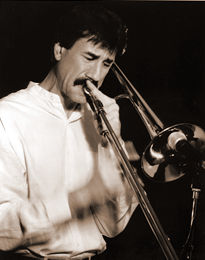 |
John Fedchock |
Practice
García: Do you recommend any particular practice regimen for developing one’s close-mic solo sound?
Anderson: No.
Davis: It seems to me it would be the same recommendation for developing a good overall sound. Have a clear mental picture of your sound at all times. Make use of your practice time to focus on sound so that when you go to play jazz, your sound is second-nature and not your primary focus. Don’t overblow the microphone.
Fedchock: I haven’t practiced for an “open-horn” or a “close-mic” sound. I just practice to have a good sound: a combination of all the good sounds (on all instruments) that I’ve heard over the years. Hours and hours of long-tones have brought me to the sound I now have. Playing into microphones has had no bearing on that. I strive to have the same qualities of timbre in my sound, whether on or off a mic. Those who have sat next me in a section know that my lead playing, even when pushing the dynamic envelope, retains the same qualities present in my softer microphone-playing.
J.J. Johnson had a similar view about sound-quality and playing-volume. He relayed one of his practice concepts to Steve Turre, as quoted in an October 1997 JazzTimes article “’Bone Voyage,” in which Steve said:
